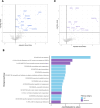Plasma proteomics for cognitive decline and dementia-A Southeast Asian cohort study
- PMID: 39998981
- PMCID: PMC11854348
- DOI: 10.1002/alz.14577
Plasma proteomics for cognitive decline and dementia-A Southeast Asian cohort study
Abstract
Introduction: The prognostic utility of plasma proteomics for cognitive decline and dementia in a Southeast Asian population characterized by high cerebrovascular disease (CeVD) burden is underexplored.
Methods: We examined this in a Singaporean memory clinic cohort of 528 subjects (n = 300, CeVD; n = 167, incident cognitive decline) followed-up for 4 years.
Results: Of 1441 plasma proteins surveyed, a 12-protein signature significantly predicted cognitive decline (q-value < .05). Sixteen diverse biological processes were implicated in cognitive decline. Ten proteins independently predicted incident dementia (q-value < .05). A unified prediction model combining plasma proteins with clinical risk factors increased the area under the curve for outcome prediction from 0.62 to 0.85. External validation in the cerebrospinal fluid proteome of an independent Caucasian cohort replicated four of the significantly predictive plasma markers for cognitive decline namely: GFAP, NEFL, AREG, and PPY.
Discussion: The prognostic proteins prioritized in our study provide robust signals in two different biological matrices, representing potential mechanistic targets for dementia and cognitive decline.
Highlights: A total of 1441 plasma proteins were profiled in a Singaporean memory clinic cohort. We report prognostic plasma protein signatures for cognitive decline and dementia. External validation was performed in the cerebrospinal fluid proteome of a Caucasian cohort. A concordant proteomic signature was identified across both biofluids and cohorts. Further studies are needed to explore the therapeutic implications of these proteins for dementia.
Keywords: Southeast Asian; blood biomarker; cerebrovascular disease; cognitive decline; incident dementia; proteomics.
© 2025 The Author(s). Alzheimer's & Dementia published by Wiley Periodicals LLC on behalf of Alzheimer's Association.
Conflict of interest statement
The authors declare no conflicts of interest. Author disclosures are available in the Supporting Information.
Figures





References
-
- International AsD . World Alzheimer Report 2018, The state of the art of dementia research: New frontiers. 2018;
MeSH terms
Substances
Grants and funding
- National University Health System Clinician Scientist Program (NCSP 2.0)
- CSDU Collaborative Grant by NUS Yong Loo Lin School of Medicine
- NMRC/CSA-SI/007/2016/National Medical Research Council
- MH 095:003/008-340/National Medical Research Council
- NMRC/CIRG/1485/2018/National Medical Research Council
- MOH-000707/National Medical Research Council
- NMRC/OFLCG/2019/National Medical Research Council
- NMRC/CG/M006/2017/National Medical Research Council
- NCSP2.0/2023/NUHS/SMA/National University Health System (NUHS) Clinician Scientist Academy
- KCG/2023/NUSMED/SMA/National University of Singapore Clinician Scientist Development Unit
- NMRC/CSA-SI/007/2016/NMRC
- MH 095:003/008-340/NMRC
LinkOut - more resources
Full Text Sources
Medical
Miscellaneous

